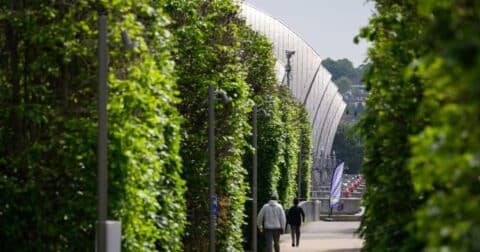Feature
Georgia Communities Are Pushing Back Against Big Chicken
Food•7 min read
Solutions
Whether hi-tech or nature-based, all climate action requires tradeoffs.


Words by Dawn Attride
It’s no secret that industrial animal agriculture is draining our planet’s resources and is one of the largest sources of greenhouse gas emissions — responsible for somewhere between 12 and nearly 20 percent of climate pollution. On a personal level, reducing meat consumption and adapting to a plant-forward diet are one of the most effective forms of climate action. When it comes to more systemic solutions however, lawmakers and development banks have favored interventions that tend to be tech-based, or human manufactured. These solutions, like dairy digesters that convert manure into biogas, or synthetic feed additives that reduce methane emissions from livestock, also tend to be hotly contested by a certain swath of environmentalists.
While such technologies promise to curb emissions, the reality is not so simple — and they also may do little to combat agriculture’s stress on water, soils and biodiversity. These strategies often don’t address issues like soil health or the deforestation of land — at least not directly.
A new report makes the case that the best way forward may lie in investing in nature-based solutions, rather than technological ones. The findings were published by The Farm Animal Investment Risk and Return Initiative (FAIRR), an investor network covering risks and opportunities in the global food system.
A nature-based solution uses natural techniques and ecosystems to address environmental challenges, such as planting trees or restoring wetlands to capture carbon.
The new FAIRR report is the “first of its kind” in developing a framework to attract investment for long-term climate solutions in a way that considers the whole planet holistically, Sajeev Mohankumar, senior technical specialist of climate and biodiversity at FAIRR, tells Sentient.
“Industrial farming produces more calories and produces more product per unit area because they are so efficient and their only goal is to maximize profit. But what we wanted to emphasize in this report is that that is not the only system of agriculture –– it also has to deliver for the animals in terms of welfare, human health and planetary health. That’s where nature-based solutions come into play,” he says.
FAIRR evaluated 22 on-farm interventions (12 nature-based, 10 tech-based) often cited to address agriculture’s climate and nature risks. They found that nature-based solutions such as hedgerows (rows of shrubs that act as a carbon sink and reduce soil erosion) and silvopasture (integrating trees into grazing pastures) had a greater positive impact collectively on emissions reductions, biodiversity, freshwater use and the flow of nutrients across ecosystems. “Nature-based interventions can deliver 37 percent of the mitigation required to meet 2030 climate targets, along with significant nature co-benefits,” the report states.
Nature-based solutions are touted as offering more holistic rewards, but can take time to show impact, which can be difficult to sell to investors. “I think there is a lack of knowledge in terms of connecting some of the financial returns to environmental outcomes,” Mohankumar says. “This involves changing the behavior of farmers and tying them into a long-term contract…it takes a long time to yield benefits.”
For example, technology like synthetic animal feed additives reduce methane emissions from livestock by roughly 10-30 percent, but offer few co-benefits for nature. Hedgerows, by comparison, reduce emissions but also have positive environmental benefits, such as reducing soil erosion and curbing nutrient runoff into water. On the other hand, hedgerows need to be planted in large quantities, and require a long timescale of up to 10 years to sequester significant amounts of carbon.
Nature-based solutions have another added benefit: they tend to boost climate resilience, often in a more cost-effective way, according to a recent review of over 100 peer-reviewed articles. Sixty-five percent of studies found that nature-based solutions were better at reducing disaster risk, and 71 percent of studies found that they were more cost-effective than tech-based ones.
Currently, the majority of on–farm intervention investment flows toward technological advances, which, FAIRR says is “concerning.” This is because tech-based climate interventions “are more likely to be aligned with intensive livestock production practices, and lead only to incremental emissions reductions relative to the long-term systemic changes from implementing nature-based interventions.” In other words, these solutions cut down on emissions a little, without addressing the problems caused by industrial food systems, like poor animal welfare or water pollution.
Not every climate researcher sees a clear preference for technology or nature-based solutions. Sentient asked Richard Waite, director for Agriculture Initiatives, Food, Land and Water Program at the World Resources Institute (WRI), to take a look at FAIRR’s research, with which he was not involved. Waite was a co-author of a 2019 report from WRI that recommended a suite of solutions to meet the challenge of feeding even more people on the planet — 9.7 billion by 2050 — without draining natural resources and driving up global temperatures to an unhealthy degree.
“This report looks at many interventions that are commonly cited when talking about reducing agriculture’s impacts on climate and nature. It recommends more investment in nature-based solutions, while also noting that such interventions may lower food production,” Waite tells Sentient.
“In our world of increasing food demand linked to agricultural expansion and deforestation,” says Waite, “we must be very careful to assess any tradeoffs related to shifting to agricultural systems or practices that produce less food and require more land.”
When it comes to food systems, tradeoffs can have significant consequences. For instance, shifting a factory farm to a regenerative beef operation could mean more space for farm animals to roam. That sounds like a better scenario for farm animals. But research has also shown that regenerative cattle ranches use twice as much land to produce the same amount of food. If Americans and other Global North populations were to continue to eat meat at even close to the same levels they do now, there is simply not enough farmland to shift all industrial farms to regenerative operations. And trying to make that shift would undoubtedly result in more emissions and more deforestation.
For Waite and WRI, a mix of solutions is key. “Our own research suggests that both tech-based and nature-based solutions will be essential to feeding 10 billion people by 2050, while protecting nature and the climate.”
Fierce debates over climate solutions seem to be going strong, yet global temperatures — and food system emissions — continue to be heading in the wrong direction. If countries are serious about meeting their climate goals, they will likely need to consider comprehensive solutions that account for impacts to both climate and nature.